The rubber mixing mill was the first type of mixing machine developed for the processing of rubber; it fulfilled the need for a machine that could both soften and knead the rubber into a usable state and also roll it into a sheet in preparation for use.
The original machine was developed in 1820 and had a single roll that was operated by hand-crank; this machine and was used to soften and compress leftover scraps of rubber into a soft, usable state, thus reducing the amount of waste from goods production. In the 1830s, a more advanced machine was developed, which could not only soften scraps of rubber into a dough but also press it into sheets. Modern mills are automatic, but they still retain the simple construction style of the originals and so are easy to operate and maintain.
The salient feature of a rubber mixing mill is the two rollers between which the polymer is placed, where it is compressed until it forms an even belt; the rollers are designed for minimal friction, to ensure the resulting belt of rubber is smooth and even. At this point, extra chemicals such as fillers, plasticizers, and finally curing agents are added to the mill, where they are mixed until fully incorporated into the rubber. A smooth, even blending of the components is essential for a quality product.
Mixing mills can be used to process a wide variety of feeds, and their versatile nature makes them suitable for short production runs of all types of rubber goods. The machines come in a wide range of sizes, with rollers ranging from 6 inches to 30 inches in diameter.


